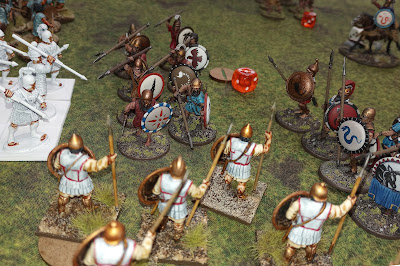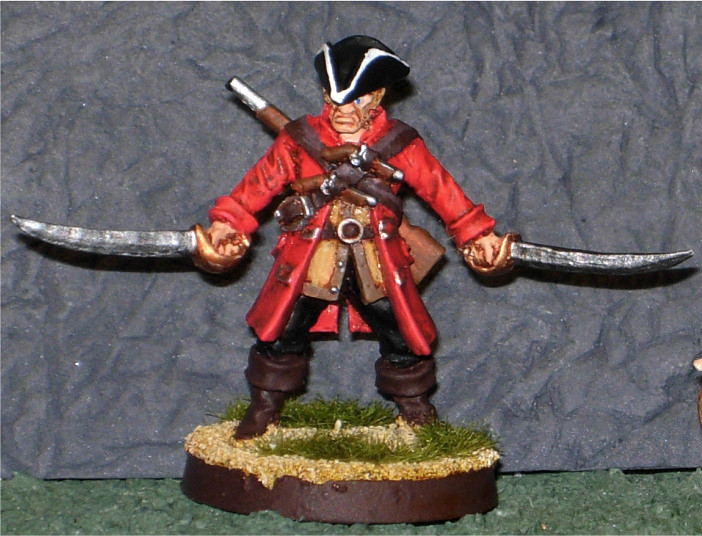 |
| A wall of Carthaginian shields and spears! |
Juba sat astride his horse, stretching without dismounting. For three days and three nights he and his Numidians had been almost constantly in the saddle, shadowing a force of Greek mercenaries. His orders from Malchus had been simple - herd them to a place where we can fight them, and destroy them.
The Greeks were wily, and had not allowed themselves to be caught in a disadvantageous position. Nevertheless, Juba's riders had found the occasional opportunity to throw a few javelins their way, just to remind them they were being watched.
The Numidian's mounts afforded them a level of mobility denied to the Greeks. Juba had a detachment of his horsemen trailing the Greeks, looking for openings to attack their baggage. He also had riders out in front, scouting the terrain.
One of them galloped up to him now, reining in his horse at the last moment. "Agellid (chief)," he said, "There is a farmstead ahead about a half day's ride. The Greeks are headed directly for it."
That's what Juba had been waiting for. A place, and a plan. "Excellent," he replied, turning to another rider, this one on a fresher mount. "Ride to Malchus, quickly, and tell him where the trap can be sprung. We will meet him there, and bring the Greeks to heel."
____________________________________________
Turn 3 of the Clash campaign is upon us! After a very busy February work-wise, I was finally able to get a game in against Sean and his Greeks. Without further ado, here's what happened...
Sean and I rolled for choice of scenario, and he won - so much for choosing the recon scenario. Knowing that his armored Greeks would have an advantage when getting stuck in, Sean opted for "This is my Land."
Deployment went well for me, as my lighter troops and cavalry could push forward, locking Sean's units a little further from the objectives than my own troops. Alas, this slight advantage would not mean much during the game itself.
 |
| Initial troop positions. |
 |
| Sean's javelin throwers get comfortable in the woods. |
 |
| Sean's line. |
 |
| Libyan javelin men move into a field. |
 |
| Two units of Numidian horsemen on my right flank. |
_____________________________________________
Malchus glared across the battlefield at his foe. That damned Greek gold-grubbing bastard! He had faced him before and been bested by him. But this time would be different!
The opposing forces faced each other across a small farm, with copses of palms and some scattered buildings. Malchus' light, mostly skirmishing troops were at a disadvantage against the Greeks in a stand-up battle. He had tried to catch them on the move, when they would be ill-prepared, but that had not happened.
Nevertheless, he gave his lieutenants and prepared to face the foe.
_______________________________________________
Turn 1 saw fairly routine advances on both flanks. My cavalry was massed on the left, and my infantry ion the right. Sean had a more balanced line, with missile troops flanking and supporting his infantry.
 |
| Sean's spearmen advance towards the center. |
 |
| More javelin men advance into the woods. |
Turn 2 began with my cavalry tossing some pointy sticks at Sean's troops, doing some damage, but not enough. On the right side, the heavier infantry positioned themselves for a fight!
 |
| Positions at start of Turn 2. |
 |
| Numidians begin their charge. |
 |
| First blood, though a trickle, to me! |
____________________________________________
Thus far, Malchus could see that his strategy was working. He had massed light troops on one flank, hoping to whittle down the enemy without engaging full-on. On his right, under Bostar's watchful eyes, he had placed his two heavy infantry units where they could support each other as they advanced.
____________________________________________
 |
| Carthaginian spearmen charge Greek hoplites. |
 |
| First round of combat was indecisive. |
 |
| Charge and countercharge begins. |
 |
| More Clashing of spears. |
Turn 4 is when Carthaginian blood started to flow in earnest. Sean was able to flank charge my spearmen, who had just finished charging Sean's hoplites. The charge into the flank wiped the unit out. In the center, my javelin unit had peaked out to toss some of their missiles, to little effect. They lost some men to Sean's counterfire. This, combined with the fatigue that had been accumulated, left them as easy pickings for Aristarchus, who charged in, wiped out the skirmishers, and then bravely advanced rearward back towards his own lines.
 |
| Sean's hoplites take advantage of the Carthaginian disorder to flank charge, |
 |
| The weakened unit is wiped out. |
 |
| My Romanized veterans are now heavily outnumbered. |
 |
| Aristarchus charges, wiping out the fatigued javelin men. |
 |
| Sean's hoplites hold off the cavalry's vain final attempts. |
____________________________________________
____________________________________________
 |
| Aristarchus again chooses his target wisely. |
____________________________________________
____________________________________________
This gave Sean a minor victory!
 |
| Final troop positions. |
____________________________________________
As dusk settled on the farm, Malchus reluctantly gave the order to withdraw. His men, though bloodied and weary, retired in good order. How it galled him to cede the field to that Greek coin counter!
They had hurt the Greeks, that was sure, but not enough. And his own troops had suffered more.
As he walked alongside his men, Malchus and Bostar discussed the skirmish, and its outcome. Malchus analyzed every aspect, looking for a weakness that he had failed to exploit in the moment, but that he could use the next time they faced this Greek scum. They would face him again, he was sure of it. Sicilia was not that large an island. And next time he would be ready. "Juba," he called out to the leader of his cavalry, "I have a new mission for you. Find me a horse!"
____________________________________________
Points of interest:
I love cavalry and will keep using them, but slingers are my bane, handing them light casualties but enough fatigue to render the unit ineffective in the late stages of the game. I had several units fail to activate in the final turn. While this may not have changed the outcome, it certainly didn't help.
My dice seem to roll better when I need sixes. My rolls were decidedly average when needing fours or fives. But on several rolls when needing sixes the dice came up big. Unfortunately, since Sean's elite troops were usually defending, this did not result in as many casualties as I would have wished.
I think that finding Malchus a mount for next turn will be a priority. The ability of Sean's commander to ride up, dispatch a weakened unit, and then slink behind enemy lines was a huge factor in the game. Aristarchus himself dispatched one break point worth of troops, which was the difference in the game.
Sean's javelin men on the right flank got a good view of the battle and a day's rest, not moving once from their initial position. Their jeering and catcalls, I believe, are what turned the tide of battle against me.
 |
| Look familiar? Sean's javelin men haven't moved. |
As always, a tight game against Sean, and one in which some things went right, some went wrong, some went really wrong, and I was unable to score enough kills to pull out the draw. In short, it was your typical nail-biter fun Clash of Spears game!
'Til next time!
(I am including a link to a totally biased, unfactual, skewed version of events from Aristarchus' point of view on Sean's blog. In all seriousness, it is an excellent representation of what happened, and you know what they say about the victors writing history.)
































